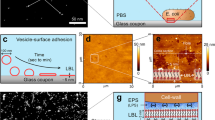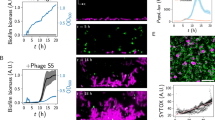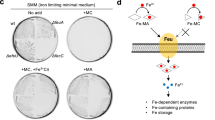Abstract
Recent studies have revealed that the regulated death of bacterial cells is important for biofilm development. Following cell death, a sub-population of the dead bacteria lyse and release genomic DNA, which then has an essential role in intercellular adhesion and biofilm stability. This Opinion focuses on the role of regulated cell death and lysis in biofilm development and provides a functional comparison between bacterial programmed cell death and apoptosis. The hypothesis that the differential regulation of these processes during biofilm development contributes to the antibiotic tolerance of biofilm cells is also explored.
This is a preview of subscription content, access via your institution
Access options
Access to this article via ICE Institution of Civil Engineers is not available.
Subscribe to this journal
Receive 12 print issues and online access
$209.00 per year
only $17.42 per issue
Buy this article
- Purchase on SpringerLink
- Instant access to full article PDF
Prices may be subject to local taxes which are calculated during checkout


Similar content being viewed by others
References
Lewis, K. Programmed death in bacteria. Microbiol. Mol. Biol. Rev. 64, 503–514 (2000).
Hetts, S. W. To die or not to die: an overview of apoptosis and its role in disease. JAMA 279, 300–307 (1998).
Lewis, K. Riddle of biofilm resistance. Antimicrob. Agents Chemother. 45, 999–1007 (2001).
Claverys, J. P. & Havarstein, L. S. Cannibalism and fratricide: mechanisms and raisons d'etre. Nature Rev. Microbiol. 5, 219–229 (2007).
Davis, B. D., Chen, L. L. & Tai, P. C. Misread protein creates membrane channels: an essential step in the bactericidal action of aminoglycosides. Proc. Natl Acad. Sci. USA 83, 6164–6168 (1986).
Giesbrecht, P., Kersten, T., Maidhof, H. & Wecke, J. Staphylococcal cell wall: morphogenesis and fatal variations in the presence of penicillin. Microbiol. Mol. Biol. Rev. 62, 1371–1414 (1998).
Malik, M., Zhao, X. & Drlica, K. Lethal fragmentation of bacterial chromosomes mediated by DNA gyrase and quinolones. Mol. Microbiol. 61, 810–825 (2006).
Horne, D. & Tomasz, A. Tolerant response of Streptococcus sanguis to β-lactams and other cell wall inhibitors. Antimicrob. Agents Chemother. 11, 888–896 (1977).
Groicher, K. H., Firek, B. A., Fujimoto, D. F. & Bayles, K. W. The Staphylococcus aureus lrgAB operon modulates murein hydrolase activity and penicillin tolerance. J. Bacteriol. 182, 1794–1801 (2000).
Rice, K. C. et al. The Staphylococcus aureus cidAB operon: evaluation of its role in the regulation of murein hydrolase activity and penicillin tolerance. J. Bacteriol. 185, 2635–2643 (2003).
Rice, K. C., Nelson, J. B., Patton, T. G., Yang, S. J. & Bayles, K. W. Acetic acid induces expression of the Staphylococcus aureus cidABC and lrgAB murein hydrolase regulator operons. J. Bacteriol. 187, 813–821 (2005).
Bayles, K. W. The bactericidal action of penicillin: new clues to an unsolved mystery. Trends Microbiol. 8, 274–278 (2000).
Bayles, K. W. Are the molecular strategies that control apoptosis conserved in bacteria? Trends Microbiol. 11, 306–311 (2003).
Rice, K. C. & Bayles, K. W. Death's toolbox: examining the molecular components of bacterial programmed cell death. Mol. Microbiol. 50, 729–738 (2003).
Wang, I. N., Smith, D. L. & Young, R. Holins: the protein clocks of bacteriophage infections. Ann. Rev. Microbiol. 54, 799–825 (2000).
Park, T., Struck, D. K., Deaton, J. F. & Young, R. Topological dynamics of holins in programmed bacterial lysis. Proc. Natl Acad. Sci. USA 103, 19713–19718 (2006).
Brunskill, E. W. & Bayles, K. W. Identification of LytSR-regulated genes from Staphylococcus aureus. J. Bacteriol. 178, 5810–5812 (1996).
Patton, T. G., Rice, K. C., Foster, M. K. & Bayles, K. W. The Staphylococcus aureus cidC gene encodes a pyruvate oxidase that affects acetate metabolism and cell death in stationary phase. Mol. Microbiol. 56, 1664–1674 (2005).
Yang, S. J., Dunman, P. M., Projan, S. J. & Bayles, K. W. Characterization of the Staphylococcus aureus CidR regulon: elucidation of a novel role for acetoin metabolism in cell death and lysis. Mol. Microbiol. 60, 458–468 (2006).
Yang, S. J. et al. A LysR-type regulator, CidR, is required for induction of the Staphylococcus aureus cidABC operon. J. Bacteriol. 187, 5893–5900 (2005).
Patton, T. G., Yang, S. J. & Bayles, K. W. The role of proton motive force in expression of the Staphylococcus aureus cid and lrg operons. Mol. Microbiol. 59, 1395–1404 (2006).
Green, D. R. & Reed, J. C. Mitochondria and apoptosis. Science 281, 1309–1312 (1998).
Reed, J. C. et al. BCL-2 family proteins: regulators of cell death involved in the pathogenesis of cancer and resistance to therapy. J. Cell. Biochem. 60, 23–32 (1996).
Schmidt, H., Bukholm, G. & Holberg-Petersen, M. Adhesiveness and invasiveness of staphylococcal species in a cell culture model. APMIS 97, 655–660 (1989).
White, E. Mechanisms of apoptosis regulation by viral oncogenes in infection and tumorigenesis. Cell Death Differ. 13, 1371–1377 (2006).
Antonsson, B., Montessuit, S., Lauper, S., Eskes, R. & Martinou, J. C. Bax oligomerization is required for channel-forming activity in liposomes and to trigger cytochrome c release from mitochondria. Biochem. J. 345, 271–278 (2000).
Antonsson, B., Montessuit, S., Sanchez, B. & Martinou, J. C. Bax is present as a high molecular weight oligomer/complex in the mitochondrial membrane of apoptotic cells. J. Biol. Chem. 276, 11615–11623 (2001).
Armstrong, J. S. Mitochondrial membrane permeabilization: the sine qua non for cell death. Bioessays 28, 253–260 (2006).
Soane, L. & Fiskum, G. Inhibition of mitochondrial neural cell death pathways by protein transduction of Bcl-2 family proteins. J. Bioenerg. Biomembr. 37, 179–190 (2005).
Kroemer, G., Galluzzi, L. & Brenner, C. Mitochondrial membrane permeabilization in cell death. Physiol. Rev. 87, 99–163 (2007).
Reed, J. C. Dysregulation of apoptosis in cancer. J. Clin. Oncol. 17, 2941–2953 (1999).
Gautam, S. & Sharma, A. Involvement of caspase-3-like protein in rapid cell death of Xanthomonas. Mol. Microbiol. 44, 393–401 (2002).
Raju, K. K., Gautam, S. & Sharma, A. Molecules involved in the modulation of rapid cell death in Xanthomonas. J. Bacteriol. 188, 5408–5416 (2006).
Kirkin, V., Joos, S. & Zornig, M. The role of Bcl-2 family members in tumorigenesis. Biochim. Biophys. Acta 1644, 229–249 (2004).
Schmitt, C. A., Rosenthal, C. T. & Lowe, S. W. Genetic analysis of chemoresistance in primary murine lymphomas. Nature Med. 6, 1029–1035 (2000).
Rice, K. C. et al. The cidA murein hydrolase regulator contributes to DNA release and biofilm development in Staphylococcus aureus. Proc. Natl Acad. Sci. USA 104, 8113–8118 (2007).
Whitchurch, C. B., Tolker-Nielsen, T., Ragas, P. C. & Mattick, J. S. Extracellular DNA required for bacterial biofilm formation. Science 295, 1487 (2002).
Allesen-Holm, M. et al. A characterization of DNA release in Pseudomonas aeruginosa cultures and biofilms. Mol. Microbiol. 59, 1114–1128 (2006).
Qin, Z. et al. Role of autolysin-mediated DNA release in biofilm formation of Staphylococcus epidermidis. Microbiology 153, 2083–2092 (2007).
Webb, J. S. et al. Cell death in Pseudomonas aeruginosa biofilm development. J. Bacteriol. 185, 4585–4592 (2003).
Mai-Prochnow, A. et al. Biofilm development and cell death in the marine bacterium Pseudoalteromonas tunicata. Appl. Environ. Microbiol. 70, 3232–3238 (2004).
Mai-Prochnow, A., Webb, J. S., Ferrari, B. C. & Kjelleberg, S. Ecological advantages of autolysis during the development and dispersal of Pseudoalteromonas tunicata biofilms. Appl. Environ. Microbiol. 72, 5414–5420 (2006).
Panaretakis, T., Pokrovskaja, K., Shoshan, M. C. & Grander, D. Activation of Bak, Bax, and BH3-only proteins in the apoptotic response to doxorubicin. J. Biol. Chem. 277, 44317–44326 (2002).
Real, P. J. et al. Breast cancer cells can evade apoptosis-mediated selective killing by a novel small molecule inhibitor of Bcl-2. Cancer Res. 64, 7947–7953 (2004).
Real, P. J. et al. Resistance to chemotherapy via Stat3-dependent overexpression of Bcl-2 in metastatic breast cancer cells. Oncogene 21, 7611–7618 (2002).
Anderl, J. N., Zahller, J., Roe, F. & Stewart, P. S. Role of nutrient limitation and stationary-phase existence in Klebsiella pneumoniae biofilm resistance to ampicillin and ciprofloxacin. Antimicrob. Agents Chemother. 47, 1251–1256 (2003).
Anderl, J. N., Franklin, M. J. & Stewart, P. S. Role of antibiotic penetration limitation in Klebsiella pneumoniae biofilm resistance to ampicillin and ciprofloxacin. Antimicrob. Agents Chemother. 44, 1818–1824 (2000).
Stewart, P. S. & Costerton, J. W. Antibiotic resistance of bacteria in biofilms. Lancet 358, 135–138 (2001).
Tomasz, A., Albino, A. & Zanati, E. Multiple antibiotic resistance in a bacterium with suppressed autolytic system. Nature 227, 138–140 (1970).
Tuomanen, E., Durack, D. T. & Tomasz, A. Antibiotic tolerance among clinical isolates of bacteria. Antimicrob. Agents Chemother. 30, 521–527 (1986).
Acknowledgements
The author would like to thank M. Chaussee, K. Rice, G. Somerville and R. Young for helpful comments and suggestions made during the preparation of this manuscript. In addition, the assistance of V. Vonstein in compiling the list of cid and lrg homologues is appreciated. This comparative analysis was performed in the SEED environment, which was developed by the Fellowship for Interpretation of Genomes in collaboration with an international team of researchers and is available through the National Microbial Pathogen Data Resource. Support was provided by the National Institutes of Health (R01AI038,901) and the US Department of Defense (DAAD 19-03-1-0191).
Author information
Authors and Affiliations
Ethics declarations
Competing interests
The author declares no competing financial interests.
Related links
Related links
DATABASES
Entrez Genome Project
Entrez Protein
FURTHER INFORMATION
Rights and permissions
About this article
Cite this article
Bayles, K. The biological role of death and lysis in biofilm development. Nat Rev Microbiol 5, 721–726 (2007). https://doi.org/10.1038/nrmicro1743
Issue Date:
DOI: https://doi.org/10.1038/nrmicro1743



